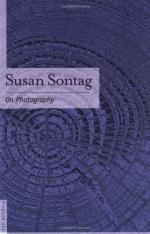
|
| Name: _________________________ | Period: ___________________ |
This test consists of 15 multiple choice questions and 5 short answer questions.
Multiple Choice Questions
1. The prisoners in the cave see only shadows, and thus believe those shadows are the totality of ____________.
(a) Their days.
(b) Their families.
(c) Reality.
(d) Their food.
2. Photography seems to establish what is worth __________ and what should be in a photograph.
(a) Looking at.
(b) Avoidance.
(c) Money.
(d) Worship.
3. ________ Whitman is the focus of this chapter, even though he was not a photographer in his time.
(a) Walt.
(b) Joe.
(c) Terrence.
(d) Phillip.
4. Whitman strove to argue that the world should be seen as a ______________ whole, welded together.
(a) Homogeneous.
(b) Peaceful.
(c) Heterogeneous.
(d) Hand-holding.
5. What is NOT one of the groups of people that Arbus photographed during her career?
(a) Prostitutes.
(b) Insane.
(c) Lepers.
(d) Deformed.
6. Surrealism is bound by ________ and is dated in its contents, according to Sontag.
(a) Art.
(b) Authors.
(c) Frame.
(d) Class.
7. What did the acronym FSA stand for in relation to the most ambitious collection photographic project?
(a) Farm Service Administration.
(b) Farm Settler Administration.
(c) Farm Service Association.
(d) Farm Security Administration.
8. Camera use is especially pronounced in tourists who come from cultures that stress activity and ______________.
(a) Accomplishment.
(b) Technology.
(c) Art.
(d) Committment.
9. What picture of Steichen's was composed of portraiture that showed the universal in the individual?
(a) Family of One.
(b) Family of the Universal.
(c) Family of All.
(d) Family of Man.
10. In his photographs, Steichen gave ___________ material importance according to Sontag.
(a) Peaceful.
(b) Dark.
(c) Irrelevant.
(d) Disgusting.
11. What might separate the whole of humanity, according to Whitman in this chapter of this book?
(a) Beauty.
(b) Photography.
(c) Superficial distinctions.
(d) Criticisms.
12. Like surrealism, photography is often about ________ poverty and wealth in its contents or its themes.
(a) Extreme.
(b) Duly earned.
(c) Abject.
(d) True.
13. Photographers sought to illustrate ____________in discord, or a polity among banal and trivial subjects.
(a) Wonder.
(b) Accord.
(c) Truth.
(d) Concord.
14. American photographers feel the country is simply too _______ to be understood - instead it must simply be catalogued.
(a) Important.
(b) Old.
(c) Big.
(d) Good.
15. Some photographers are _________, seeking to clarify or to identify a world vision.
(a) Students.
(b) Scientists.
(c) Moralists.
(d) Teachers.
Short Answer Questions
1. Photography yields to viewers _____________ to look and to act as a sort of voyeur without repercussion.
2. What kind of takeover did photography's influence lead to, according to Sontag?
3. As a result of being considered to be documentation, photographs yield a _______ that no other art form can yield.
4. The cave allegory speaks of __________ chained to a wall within the story itself.
5. With the help of captions, photographs can be made to speak, but the caption is obviously ____________.
|
This section contains 404 words (approx. 2 pages at 300 words per page) |

|




